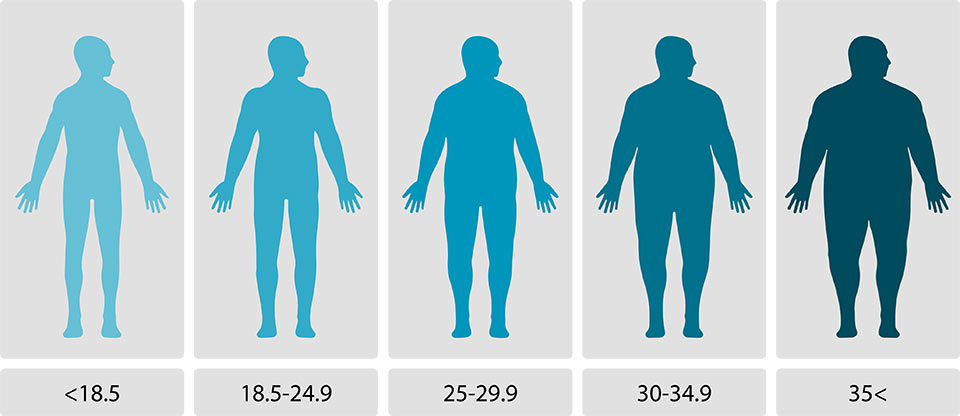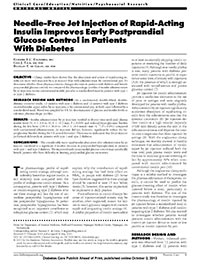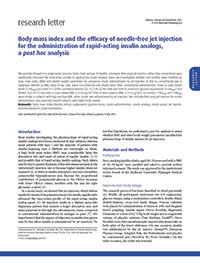
Improved early postprandial glucose control
InsuJet™ for professionals
On this page you will find more background information meant for medical professionals. Please contact an InsuJet™ distributor, or use the contact form below if you require additional information about the InsuJet™.
Publications
Insulin administered by needle-free jet injection corrects marked hyperglycaemia faster in overweight or obese patients with diabetes
Adult, overweight or obese (BMI ≥25 and ≤40 kg/m2) patients with type 1 diabetes (n=10) or insulin-treated type 2 diabetes (n=10) were enrolled in a randomized, controlled, crossover study. On two separate occasions, patients were instructed to reduce insulin dose(s) to achieve marked hyperglycaemia (18–23 mmol/l). Subsequently, insulin aspart was administered either by jet injection or by conventional pen, in a dose based on estimated individual insulin sensitivity. Pharmacodynamic and pharmacokinetic profiles were derived from plasma glucose and insulin levels, measured for 6 h after injection.
It was concluded that administration of rapid-acting insulin by jet injection results in faster correction ofmarked hyperglycaemia in overweight or obese patients with insulin-requiring diabetes.
A Pilot Study to Examine the Tolerability and Device Preference in Type 1 Diabetes of Insulin Apart Administered by InsuJet™ Compared with Subcutaneous Injection.
Jet injectors allow needle-free insulin delivery. The study objective was to compare the tolerability and device preference of subcutaneous insulin aspart delivery by jet injector with pen injection in an open-label, randomized, crossover pilot study.
In this small pilot study, the devices were similar in glucose excursion in the area under the glucose concentration–time curve corrected for baseline glucose level and in insulin absorption. Devices were similar for participant preference and relative injection pain.
It was concluded that subcutaneous jet injection of aspart insulin was well tolerated.
Improved Early Postprandial Glucose Control.
Clamp studies have shown that the absorption and action of rapid-acting insulin are faster with injection by a jet injector than with administration by conventional pen. To determine whether these pharmacokinetic changes also exist in patients with diabetes and benefit postprandial glucose control, a comparison was made of the pharmacologic profiles of insulin administration by jet injection versus conventional insulin pen after a standardized meal in patients with type 1 or type 2 diabetes.
Results showed that insulin administration by jet injection resulted in shorter time until peak plasma insulin level and reduced hyperglycemic burden during the first hour compared with conventional ad-ministration. Jet injection did not, however, significantly reduce the hyperglycemic burden during the 5-h period thereafter. There was no indication that the jet injector performed differently in patients with type 1 and type 2 diabetes.
It was concluded that the considerably more rapid insulin absorption after administration by jet injector translated to a significant if modest decrease in postprandial hyperglycemia in patients with type 1 and type 2 diabetes. The improved early postprandial glucose control may specifically benefit patients who have difficulty in limiting postprandial glucose excursions.
Jet injection for insulin administration may especially benefit subjects with higher BMI

In a euglycaemic glucose clamp study with healthy volunteers it was showed that using jet injectors, rather than conventional pens, significantly improved the time-action profiles of rapid-acting insulin analogs. Here, it was investigated whether such profiles were modified by body mass index (BMI) and related weight parameters by comparing insulin administration by jet injection to that by conventional pen in subgroups defined by BMI, waist-to-hip ratio, waist circumference and insulin dose.
After conventional administration, times to peak insulin levels (T-INSmax) occurred 31.1 [95% confidence interval (CI) 13.7–48.5] minutes later and time to maximum glucose requirement (T-GIRmax) 56.9 (95%CI 26.6–87.3) minutes later in more obese (BMI > 23.6 kg/m2) than in lean subjects (BMI < 23.6 kg/m2). In contrast, T-INSmax and T-GIRmax were similar in subjects with high and low BMI, when insulin was administered by jet injection.
It was concluded that using jet injection for insulin administration may especially benefit subjects with higher body weight.
Needle-Free Jet Injection Technology improves Pharmacokinetic and Pharmacodynamic Profile of Rapid-Acting Insulin
InsuJet™ ‘s clinical trials, performed by a renowned Dutch academic hospital, were performed to com-pare the pharmacologic profile of administration of insulin aspart by jet injection to that by convention-al insulin pen.
Results showed that the time to maximal GIR was significantly shorter when insulin was injected with the jet injector, compared with conventional pen administration. The time to peak insulin concentration was similarly reduced and peak insulin concentrations were increased. Jet injector insulin administration reduced the time to 50% glucose disposal. No differences were measured in maximal GIR, total insulin absorption, or total insulin action between the two devices.
Conclusions were drawn that administration of insulin aspart by jet injection enhances insulin absorption and reduces the duration of glucose-lowering action. This profile resembles more closely the pat-tern of endogenous insulin secretion and may help to achieve better meal insulin coverage and correction of postprandial glucose excursions.
Request additional information
Please note that the request form is intended for medical professionals.




